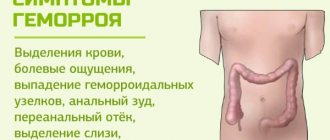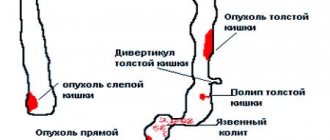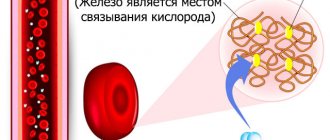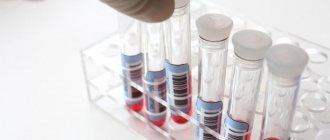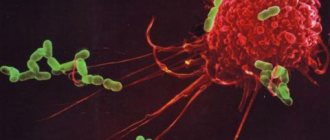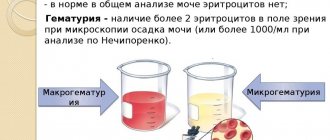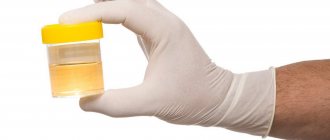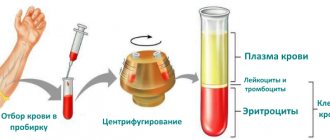What is a coprogram
Sometimes in the hospital a swab is taken from the baby's anus. More often you have to take a general stool test, called a coprogram. When a child is prescribed this test, some mothers worry, associating this with suspected dysbiosis.
In fact, a coprogram is a more overview test compared to other types of tests. Stool examination allows:
- obtain complete information about the general condition of the digestive system;
- deal with problems affecting the liver and bile ducts;
- detect infectious diseases;
- identify the presence of negative microorganisms;
- to clarify whether a hereditary factor is present in the failure of metabolic processes.
Based on the above, one can understand what scatology of feces is in infants and older children. Studying feces from a scientific point of view helps to consider the child’s condition from the perspective of 2 aspects: medical and biological.
A comprehensive study of feces includes analysis of the chemical and physical properties of feces submitted for analysis, detection of characteristic and unnatural inclusions (including signs of blood). In this case, the baby’s age and feeding characteristics are taken into account.
When there is a large amount of detritus
An increased amount of detritus in the stool indicates active functioning of the pancreas and liver. If all other indicators of the coprogram are normal, then there is nothing to worry about. If mucus and leukocytes are present, it is necessary to undergo additional examination in the form of ultrasound and blood tests.
The more detritus in the stool, the better the food is digested. This is a normal state of the body, especially in childhood. Babies eat a lot of food, as they need large amounts of microelements, vitamins and energy for the growth of bones and organs.
Baby on the potty
When is a stool test ordered?
Feces for carbohydrates in an infant - interpretation of the analysis, normal values
A stool test is not a planned annual test; it is prescribed when a child has problems with the gastrointestinal tract. A referral can be issued by a pediatrician, surgeon, gastroenterologist, or infectious disease specialist based on the symptoms detected in the newborn.
Indications for taking a coprogram
- Increased frequent gas formation and bloating.
- Pain in the peritoneum.
Tummy problems
- Changes in the color of feces and their consistency.
- The presence of blood clots in the stool.
- Recurrent nausea, often progressing to vomiting.
- Poor appetite in an infant with a sharp decrease in body weight.
- Yellowness of the dermis and whites of the eyes.
- Poor condition of nails, hair, skin.
The coprogram will confirm or refute the suspicion of the presence of pathology. The effectiveness of the therapy is judged by the next portion of feces sent for analysis.
Manifestations of pathology
In children over 3 years old
Parents may notice a slight deterioration in the child’s condition: increased frequency of bowel movements, loose stool, dizziness, weakness. Diarrhea may give way to constipation, and bloating and rumbling often appear.
The main symptom is that the feces lighten in color, become greasy, glossy, and when flushed, traces remain on the toilet.
If the disease progresses, the child begins to rapidly lose weight, pain appears in the joints and bones, the skin becomes dry, and cracks appear in the corners of the lips.
Sometimes stomatitis develops, the tongue becomes bright red.
In infants
The baby's stool becomes light-colored, sticky, and has an oily sheen. The consistency of the stool is thinner than mushy . Over time, diarrhea gives way to constipation.
The skin of infants becomes dry and peeling appears on the cheeks. The child is constantly thirsty and drinks more than usual. A dry cough often appears.
How to donate feces for coprogram
Sour smell of stool in a child under one year old - causes of stench
It is easier to take biological material from potty trained children. With a baby the situation is more complicated. For the result to be reliable, the mother must know how to correctly give a coprogram to a child in the first months of life.
Note! Feces collected in a diaper are not suitable - the liquid component of the feces is absorbed into the diaper. You'll have to wait until the baby poops on the diaper.
How to prepare a child for analysis
No special preparation is required for the procedure. Before putting the baby on a diaper, he is washed. If the baby urinates before pushing, the bedding should be replaced - no urine should get into the feces.
You should not specifically stimulate the baby’s intestines with laxatives and enemas - this will distort the indicators. It is necessary to wait for natural bowel movements.
To collect feces from a child already taking medication, prescriptions are temporarily suspended (if possible) so that third-party chemical formulas do not smear the test result. Breastfeeding mothers also exclude taking medications for a day.
How to collect stool
There is no need to donate all the material that ends up on the diaper - you only need a couple of teaspoons of feces. They are placed in a special plastic jar with a tight-fitting lid. These are sold in pharmacies and are inexpensive.
Container for collecting feces
It is not recommended to take other containers (for example, puree containers). Even with thorough washing, microparticles of food remain on the inner surfaces of the jar.
Is it possible to collect stool in the evening?
Typically, laboratories accept tests in the morning (usually until 10-11 o’clock). If the mother is not sure that the baby will poop after the night, it is allowed to collect feces in the evening (at night). The jar is tightly closed with a lid and stored in the refrigerator. In the morning, the material for coprogram is immediately sent to the laboratory.
Note! Sowing is suitable for research within 6-8 hours after collection.
Treatment
Treatment should be prescribed by a specialist after all necessary tests have been carried out. As a rule, in most cases, treatment is limited to a certain diet and taking certain vitamins.
The diet is an exclusion from the child’s diet of fatty, spicy and salty foods. The most suitable dishes are steamed. Vitamins A, D, E and K help the body absorb fats. It is worth noting that vitamin complexes can be taken as disease prevention.
, medications are prescribed to treat steatorrhea . The most common of them are: Maalox, Gastal, Almagel and Creon. The timing of taking medications and the required doses are prescribed by the attending physician.
While taking medications, you must follow a diet. It is recommended to exclude fatty, spicy, smoked and fried foods from the child’s diet. It is recommended to steam food using lean meats and fish.
You should eat small portions 4-5 times a day. Teach your child to drink a glass of water every morning and then have breakfast. During the day you need to drink water, fruit drinks, compotes, teas. For additional support of the body, you should take vitamin complexes, as well as eat fresh vegetables and fruits.
Decoding coprogram indicators in children
Urine according to Nechiporenko: how to collect urine from a child under one year old, normal indicators
The feces of a breastfed and bottle-fed baby are slightly different in structure and composition. Even for one baby, these characteristics vary over a certain period.
The bulk of feces is water. The dry part is pieces of undigested food and living microorganisms in equal proportions. Any other variations in the material being studied are a reason to suspect pathology of the gastrointestinal tract and other body systems.
Having found out what kind of coprogram analysis is in a baby, it is easier for parents to decipher the indicators provided by the laboratory.
Stool consistency
The baby's stool depends on what the child eats. In newborns and children under 2 years of age, stool is not fully formed and resembles porridge. A child on IV may poop “sausage”. The baby toddler defecates a thin mass, the consistency of sour cream. With the introduction of complementary foods, the stool thickens, but continues to remain soft. If there are problems with the gastrointestinal tract, the structure of feces changes.
Hue
Normally, feces in children of the first year of life are yellow in color. During the period of gestation, minor green impurities are allowed. As soon as solid food is included in the baby's diet, a brown tint is added to the yellowness. By the age of 2, the color of feces is similar to that of adults.
Feces
Note! The bright pigment of complementary foods will briefly color the feces in the appropriate shade (pumpkin, rhubarb, beets).
Smell
The stool of a breastfeeding newborn smells like sour milk. Artificial ones have a similar aroma, but it is more pronounced. Complementary feeding changes the smell, making it closer to fecal.
pH reaction
The baby's stool is checked for the presence of acid. Ideally, the reaction of the mass under study should be neutral or slightly alkaline. In infants, a slight deviation towards the acidic side is allowed at first. Children who consume cow product have a more pronounced alkaline index.
Protein
This component should not be present in the analyses. Protein in a child’s stool is, at best, evidence of undigested food. More often this is due to inflammatory processes in the intestines, the presence of exudate or bleeding.
Reaction to occult blood
If the intestines are in perfect order, a scatological analysis will not reveal signs of blood. It appears when there are defects in the development of the intestine, inflammation, allergies, polyps, hemorrhoids, cracks in the rectum or when it prolapses.
Presence of bilirubin
A reaction to a hemoglobin breakdown product is acceptable up to 3 months of age. Later, when beneficial microflora appears in the baby’s intestines, bilirubin is transformed into another enzyme - stercobilin. This is what gives the stool a brown tint.
Slime
This component of the intestine protects its walls from the aggressive effects of feces. Normally, there should be little whitish or clear mucus coming out, and it mixes with the feces. If there is too much jelly-like discharge, an inflammatory process is suspected. In breastfed babies, copious mucus is acceptable during the pre-feeding period.
Leukocytes and red blood cells
In the first months after birth, white blood cells may be present in small quantities in the feces of the baby. A high rate indicates damage to the intestinal walls and the onset of inflammation.
Impurities in feces
A large number of red cells is a dangerous sign, signaling bleeding in the rectum or colon.
Connective tissues and muscle fibers
These components should not be present in the baby’s stool before complementary feeding is introduced. If tissues and fibers are found, it is recommended to examine the pancreas. This problem is caused by disturbances in the functioning of the digestive system and various inflammations.
Availability of fiber
In children under one year of age, the presence of undigested food of plant origin in the feces is allowed. Fiber in feces does not indicate problems with the digestive system, but rather the rapid passage of products through the gastrointestinal tract.
Detritus
The stool is checked for the amount of digested food, as well as the presence of dead bacterial cells. Detritus is normally expressed as an insignificant indicator. An upward deviation in combination with other parameters indicates the development of pathologies and requires additional examination of the baby.
Neutral fats
Up to 6 months, a small amount is normal. Subsequently, if fat is detected, the child must be examined for diseases of the small intestine, pathology of the liver or pancreas.
Starch
This is another sign that the digestive system and pancreas are not working well. An intestinal infection may be present.
Flora iodophilus and clostridine
Increased growth of bacteria indicates the development of dyspepsia, which is characterized by disruption of the process of food digestion. Failures in the functioning of the pancreas, small intestine, and stomach can also affect the development of flora.
Insufficient fermentation of food leads to rotting of protein substances collected in the gastrointestinal tract. This helps to increase the number of special bacteria - clostridines.
Crystals
Serious disruptions in the gastrointestinal tract and diseases lead to the appearance of chemicals in the feces. Crystals in stool may indicate one of the reasons:
- if tripel phosphate is detected, this is a sign of active activity of putrefactive pathogenic bacteria;
- hematoidin is formed during internal bleeding;
- Charcot-Leyden crystals indicate that helminths are present, and the body responded to them with an allergic reaction.
In the latter case, crystallization affects proteins involved in metabolic processes.
Yeasts
Such organisms cause intestinal infections. Fungi replace beneficial microflora that have died as a result of decreased immunity or under the influence of antibiotics and other strong medications.
Yeast-like fungi in the intestines
What does detritus in stool mean?
What is detritus in a child’s stool? It begins to form in the small intestine. The primary formation of feces occurs in the stomach and upper small intestine. All food is broken down and then processed in the body by enzymes. They are produced by two organs: the liver and pancreas. A lump of digested particles forms. It moves through the large intestine. There is an attachment of red blood cells, leukocytes and epithelial cells, as well as dead bacteria. Detritus consists of:
- remnants of digested food;
- epithelial cells of the intestinal mucosa;
- dead bacterial microflora cells;
- blood cells
Important! Detritus in feces is normal in children, most of it being digested food.
Results in the table: norm and deviations
Deciphering a child’s coprogram will allow us to determine the degree of health of the baby and identify serious gastrointestinal diseases (if they are present). The results of the study are summarized in a table and are comparative in nature with reference to normal indicators.
Interpretation of coprogram results
| Index | Norm | Deviations |
| Consistency | Dense, decorated. It can be soft or hard, depending on the presence of water (about 65-85%). | Water content in stool that is higher than normal leads to the development of diarrhea. Less than 60% fluid makes the stool hard and indicates dehydration. |
| Form | Cylindrical | A change in shape may be a sign of osmotic, secretory or mixed diarrhea. |
| Color | All shades of brown, yellow (sometimes olive) | Black and red stool is a sign of bleeding. Discolored - due to problems with the biliary tract. |
| Smell | Sourish, fecal | It can intensify with excess amounts of protein foods and low consumption of plant foods. A strong sour odor indicates fermentation and impaired fermentation. Fetid amber is evidence of putrefactive processes. |
| pH reaction | 7.0 – 9.0 | An acid reaction occurs against the background of active bacterial decomposition of carbohydrates. |
| Slime | In small quantities | Deviation from the norm indicates serious problems |
| Detritus | Moderate amount | |
| Leukocytes | Single manifestations | |
| Red blood cells | 0-1 | |
| Muscle fibers | Unchanged - absent, changed can be present in any quantity | |
| Intestinal epithelial cells | Allowed in small quantities | |
| Plant fiber Fatty acids Soaps Clostridine | Small indicators | |
| Blood Remains of undigested food Neutral fat Starch Crystals Iodophilic flora Yeast-like mushrooms | Completely absent |
The deciphering of the coprogram in an infant should be done by the doctor observing the child. If treatment was prescribed based on the study, after its completion repeated tests are taken and compared with the previous ones.
Analysis decoding option
If there are health problems, a small child must be examined in a timely manner. It is important to know what the coprogram of feces taken from a baby shows. Using this test, it is easy to identify the slightest deviations affecting the gastrointestinal tract.
Symptoms of pathological processes
Oxalates in the urine of a child under one year of age—causes of occurrence, calcium levels
The first manifestation of pathology is more frequent bowel movements. Oily stool appears in the baby; it may have a pasty consistency; when the feces are flushed, greasy stains remain in the toilet. The stool may remain the usual color or become lighter, with a gray tint.
Symptoms that may mean that pathological processes are developing:
- the child often coughs without sputum;
- bloating and intestinal colic;
Intestinal colic in a baby
- the baby stops gaining weight;
- mucous membranes become dry (the baby may cry without tears);
- the baby is lethargic and apathetic;
- Nausea and vomiting may occur.
Why are children prescribed coprogram?
Indications for research
Fecal analysis for coprogram is a mandatory test for children if they have signs of a functional disorder or pathological condition of the gastrointestinal tract:
- abdominal pain;
- heartburn, belching, nausea, specific taste in the mouth, vomiting;
- flatulence, constipation, diarrhea;
- abnormal appearance of feces - color, smell, volume, presence of suspicious impurities;
- mucus, pus, blood on underwear;
- pain, itching in the rectum;
- suspicion of neoplasm, helminthiasis, poisoning;
- allergies, intolerance to certain foods;
- significant, sudden weight loss for no identifiable reason.
What the analysis reveals
The coprogram allows you to detect:
- diseases of the gallbladder and bile ducts;
- pathology of the pancreas;
- functional liver disorders;
- bowel dysfunction;
- stomach diseases;
- helminthiasis;
- celiac disease;
- cancer diseases.
Indicators
The coprogram norm for an infant differs from that for older children. Pediatricians focus the attention of parents on the fact that the decoding depends on the infant’s type of nutrition: breast milk or an adapted formula.
| Indicators | Infants | "Artificials" |
| Quantity | 40-50 g/day | 30-40 g/day |
| Consistency | Mushy sticky | Putty-like |
| Color | Yellow-green, golden, yellow | Yellow-brown |
| Smell | Sourish | Putrefactive |
| Acidity | 4,8-5,8 | 6,8-7,5 |
| Presence of impurities | No particles of soluble protein, blood or mucus | No particles of soluble protein, blood or mucus |
| Stercobilin | Presence of traces of substance | Presence of traces of substance |
| Bilirubin | Eat | Eat |
| Ammonia | Absent | Absent |
| Detit | Various quantities present | Various quantities present |
| Muscle fibers | Little or no quantity | Little or no quantity |
| Connective fibers, cellulose, starch | None | None |
| Neutral fat | Minor amount | Minor amount |
| Fatty acid | A small amount of crystals | A small amount of crystals |
| Soap | A small amount of | A small amount of |
The norm implies that leukocytes in single quantities can be found in the coprogram of both an infant and a child fed with adapted formulas.
Red blood cells are a red flag, so ideally they are completely excluded from the results. If it turns out that some elements are present in minute quantities, a more accurate decoding is available only to a doctor. He will tell you if this is normal, so it is better to consult with a pediatrician rather than surf the Internet.
We collect material for analysis correctly
The coprogram studies the main indicators of feces. It will be correct only if you adhere to the basic rules for collecting material. To do this, it is advisable to use a sterile container, which can be easily purchased at any pharmacy. It consists of a small transparent container with a container inside. Feces should be collected according to this scheme.
Parents should ensure that at least two teaspoons of material gets inside the container. Collection is carried out only in a dry and completely clean container.
It is allowed to use feces only from a clean diaper. Material from a diaper is not suitable, because it contains a certain amount of sorbents. They are quickly absorbed into the liquid, so they can significantly distort the overall clinical picture.
With proper nutrition, the amount of fatty acids should remain within normal limits
Research can only be done with fresh feces. The material can be stored for no more than ten hours. This option should only be used if there are problems with stool. Long-term storage can spoil or change key indicators. If you are not sure that all rules and regulations have been followed, you should ask a laboratory technician for advice. He will advise you to store it in a cold place. You can use the refrigerator door for this.
An admixture of urine can negatively affect the result. Feces should also not come into contact with other liquids. A complete picture cannot be obtained if the stool was caused by an enema or laxative. Such feces also contain a certain amount of impurities.
The high content of fatty acids in feces can only be detected by coprogram. It is important to achieve high accuracy of the study. To do this, two days before the planned collection, you must stop taking all medications. Children should not take laxatives or anti-diarrhea substances to treat constipation. They will negatively affect the overall picture.
During the preparatory day before the analysis, it is not allowed to consume large quantities of greens, meat and fish. Vegetables and fruits can also have a negative impact. Four days before the planned test, you should eat fermented milk products, cereals, eggs and butter.
If there are objective reasons for submitting stool for analysis, then the following manipulations are not allowed before the procedure:
- Take or administer medications whose action is aimed at accelerating the process of bowel movements.
- Coloring compounds have a negative effect. These include bismuth or barium sulfate.
For a baby during breastfeeding, the question may also arise about the need to collect material for analysis. In this case, the woman must adhere to a special diet for three days. Thanks to this, it will be possible to obtain a complete clinical picture. Fatty acid salts will be contained in large quantities in the baby's stool if the woman eats chocolate, citrus fruits or eggs. That is why they are completely excluded from the diet for a while. Some products may be included in a woman’s menu during lactation, but they should be avoided before the test itself.
A woman is also not allowed to smoke or drink alcoholic beverages. The diet may include steamed cutlets, vegetable soup or liquid porridge. However, you should additionally exclude simple carbohydrates. They negatively affect the blood and increase its sugar content.
If a woman follows the following recommendations exactly, then the baby is guaranteed to have accurate stool tests. They are necessary to select the correct course of treatment.
